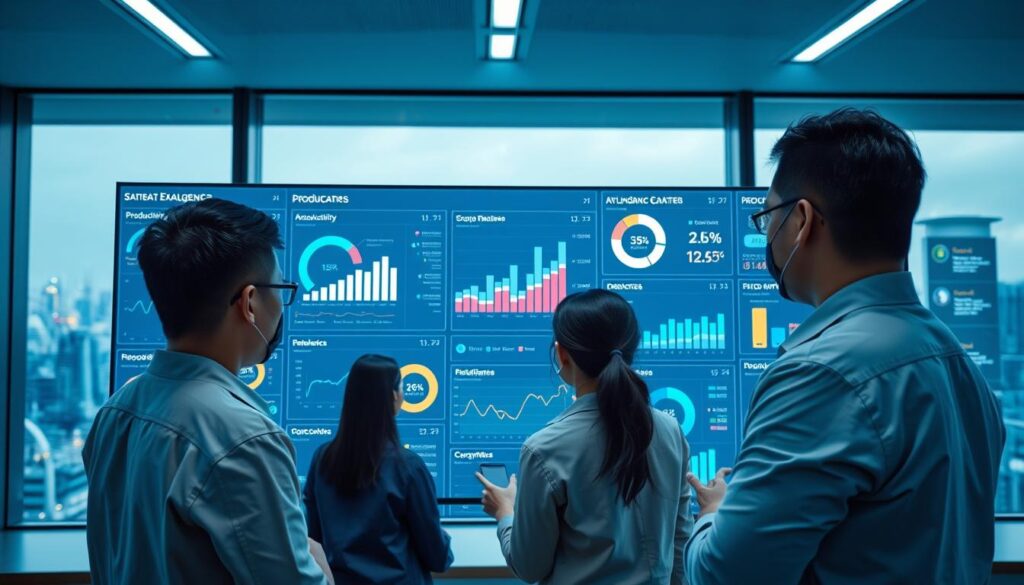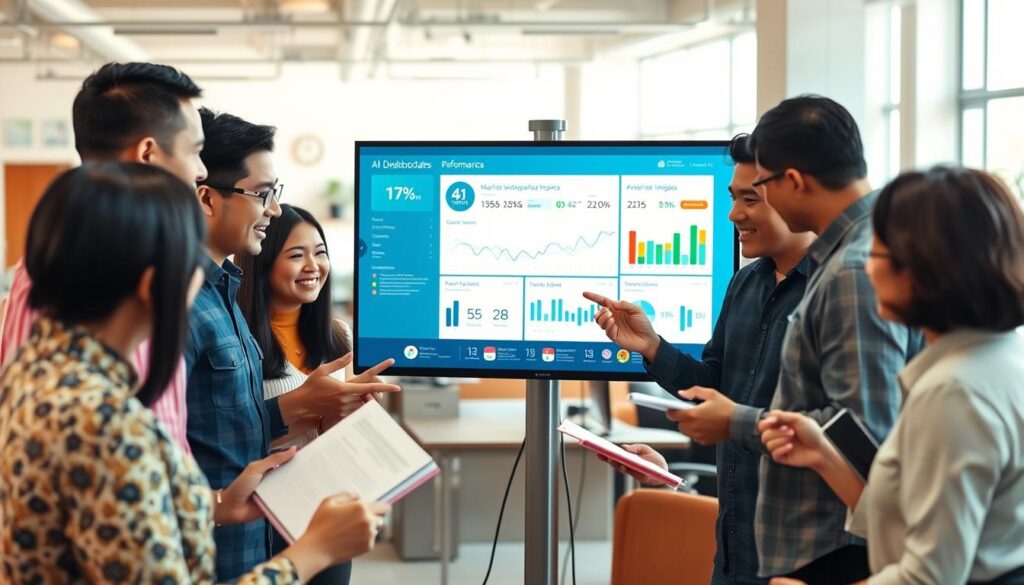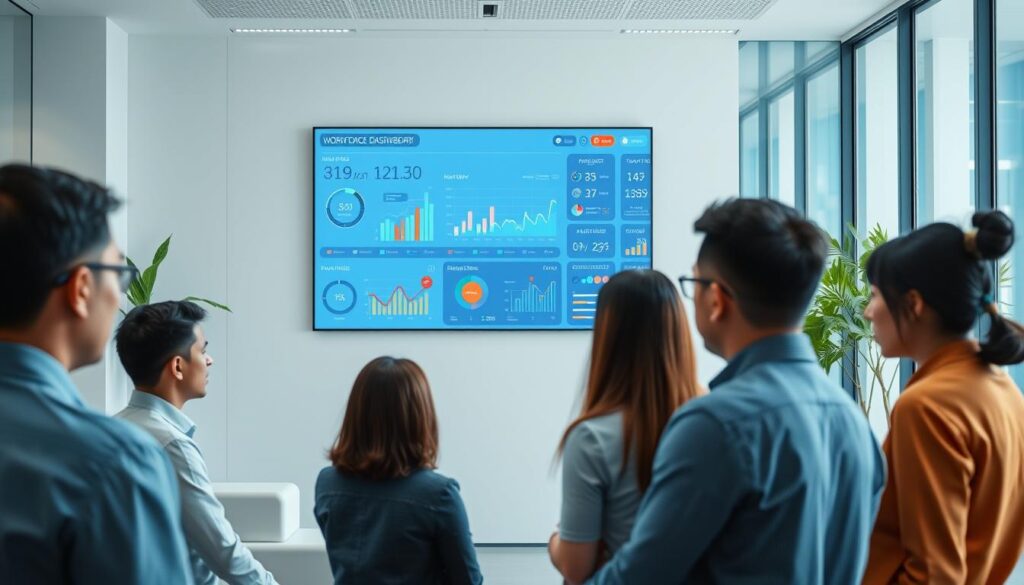Imagine how much better your business could be if you could watch your team in real time. With advanced AI dashboards, you could make quick decisions. In today’s fast world, knowing how to use real-time HR analytics is key to staying ahead.
Workforce monitoring AI has changed how we manage teams. It lets us see what’s happening right now and how well things are going. This new way of working is making businesses more efficient and effective.
Real-time monitoring is now crucial for businesses. It helps them change their plans and work better. AI dashboards in workforce analytics and planning are making decisions smarter and improving results. Let’s explore how these tools are changing how we manage our teams.
Key Takeaways
- Real-time visibility into operations enhances decision-making processes.
- AI dashboards are essential tools for effective workforce monitoring AI.
- Incorporating real-time analytics for HR boosts operational efficiency.
- Workforce Analytics & Planning is critical for strategic growth.
- Immediate data access can reshape management approaches.
Understanding the Importance of Real-Time Workforce Monitoring
Real-time workforce monitoring is key in today’s fast-paced business world. It helps companies get quick insights into how employees are doing and how tasks are being completed. This info boosts productivity and helps make better decisions with data.
Benefits of Real-Time Monitoring for Businesses
Real-time monitoring systems bring many benefits to businesses. These advantages include:
- Increased Productivity: Tracking in real-time helps spot problems early. This lets teams fix issues fast and make processes smoother.
- Improved Employee Engagement: Giving feedback in real-time keeps employees motivated. It helps them stay focused and reach their goals.
- Proactive Staffing Solutions: Companies can manage staff needs better. This prevents big problems from happening.
How Real-Time Data Transforms Decision Making
Using real-time data changes how decisions are made. It moves from reacting to acting ahead of time. This makes businesses more agile and quick to respond to changes. With analytics, companies can:
- Align Strategies with Goals: Real-time data keeps business goals in sight. It makes sure all efforts align with what’s important.
- Increase Operational Flexibility: Businesses can change plans based on current data. This encourages being adaptable.
AI Dashboards: The Future of Workforce Analytics
AI dashboards are changing the game in workforce analytics. They make data easy to see and use, helping companies manage their teams better. With these tools, managers can make quick, smart choices.
Defining AI Dashboards and Their Role in Workforce Management
AI dashboards are advanced tools for managing teams. They show trends and important performance signs. By using live data, they help spot issues like low productivity or skill gaps.
Companies use AI dashboards to boost team spirit and make work smoother. This leads to a more efficient workplace.
Key Features of Effective AI Dashboards
Effective AI dashboards have key features:
- Real-Time Data Processing: Gives users the latest info.
- Customizable Views: Lets managers pick what they need to see.
- Anomaly Detection: Finds unusual trends or behaviors.
- Performance Metrics: Shows how well individuals and teams are doing.

Leveraging Workforce Analytics & Planning for Enhanced Efficiency
Using workforce analytics can make your organization more efficient. It helps in better planning and using resources. This makes it easier to move into the digital world.
With the right HR tools, you can look at lots of data. This helps understand your workforce better. It also prepares you for changes in the market.
Integrating Workforce Analytics into Your Organization
Getting workforce analytics right needs careful planning. It must fit with your business goals. Tools can check your current team and predict future needs.
HR teams can then improve hiring and keep employees. For companies in the Philippines, knowing these tools is key to managing your workforce well.
Using Analytics to Predict Staffing Needs
Staffing prediction analytics are key for good planning. They look at past and current data to guess future needs. This helps fix skill gaps and use resources better.
Companies that use staffing prediction analytics can quickly adapt to market changes. This boosts their job performance.
The Role of AI in Automatic Data Collection
AI technologies are key in making workforce management more efficient. They help automate HR reporting tasks. This frees up HR professionals to focus on growth and engagement.
How AI Handles Routine Reporting Tasks
AI has changed how we handle routine reporting tasks. It can process huge amounts of data quickly. For example, reports that took days to make can now be done in minutes.
This saves a lot of time. It lets HR professionals work on more important tasks.
Improving Data Accuracy and Consistency
AI also makes workforce data more accurate. It reduces errors in data entry and reporting. This means the data is consistent and reliable.
Companies using AI can be sure their data is up-to-date and accurate. This is crucial in today’s fast business world.

Real-Time Data Processing: What You Need to Know
Real-time data processing changes how we watch over our workforce. It lets companies keep gathering and checking data all the time. This way, leaders can tackle problems right when they happen.
In today’s fast business world, knowing this helps leaders make quick, smart choices.
Understanding Live Data Processing in Workforce Monitoring
Live data processing makes managing the workforce clearer than ever. It captures and checks on employee work and how well things run right away. This gives teams a clear view of what’s happening every day.
They can then adjust how they use resources and meet changing needs. This is key for companies, like those in the Philippines, where things change fast.
Automatically Highlighting Trends and Anomalies
Real-time data processing does more than just show what’s happening now. It spots important trends and oddities in HR. It flags issues like unhappy employees or sudden changes in who’s working.
This lets managers jump into action fast. It helps keep the team stable and strong. By using these tools, companies stay ahead in a world that’s always changing.
Improving Employee Engagement through AI Dashboards
AI dashboards are changing how we engage employees. They help create a workplace where everyone feels valued and connected. Now, employees can see how their work helps the company reach its goals.
Using Dashboards to Foster Transparency
Being open at work builds trust and communication. AI dashboards give real-time updates on how well teams are doing. This helps everyone see how their work fits into the bigger picture.
This openness makes people more accountable and motivated. It’s a big step towards a better work environment.
Personalizing Employee Experience with Data Insights
When employees feel seen and heard, they’re happier and stay longer. AI dashboards help tailor experiences to each person’s needs. This makes everyone feel more valued and understood.

| Engagement Strategy | Description | Potential Impact |
|---|---|---|
| Real-Time Feedback | Providing instant feedback through dashboards | Increased accountability and performance improvement |
| Performance Metrics Visibility | Making performance metrics accessible to all employees | Enhanced transparency and trust within teams |
| Tailored Development Plans | Using data to create individual growth plans | Improved job satisfaction and retention rates |
Cost Management and Efficiency Through Real-Time Monitoring
AI dashboards help businesses track labor costs in real-time. They use advanced analytics to understand spending patterns. This is key for seeing how labor costs affect profits.
Accurate tracking lets companies adjust spending quickly. They can spot and fix any issues that need attention.
Tracking Labor Costs with AI Dashboards
AI dashboards make tracking labor costs easier. They collect data from various sources to offer a full view of workforce spending. This lets managers make smart decisions about staffing and budgets.
With real-time data, businesses can cut down on overtime. They can also forecast better, leading to more efficient workforce management.
Identifying Opportunities for Cost Reduction
Real-time data helps find ways to lower labor costs. AI dashboards show trends that might not be clear at first. For example, they can mix past and present data to find savings.
Employers in the Philippines can use this info to improve operations. They can do this without hurting productivity.
| Cost Tracking Method | Description | Benefits |
|---|---|---|
| Manual Tracking | Relying on spreadsheets or paper records to track labor costs. | Time-intensive, prone to errors, limited real-time insights. |
| AI Dashboards | Automated data collection providing real-time analytics on labor costs. | Improved accuracy, immediate trend identification, cost savings opportunities. |
| Integrated HR Systems | Combining labor data with HR functions for cross-analyses. | Holistic view of costs, enhanced predictive analytics, streamlined processes. |
Conducting Successful Implementation of AI Dashboards
Starting with AI dashboards needs a smart plan to get the best results. First, set clear goals and metrics that match your business aims. This helps guide the AI dashboard setup and tracks success well.
A good plan also helps teams use these tools fully. It makes sure everyone knows how to get the most out of them.
Establishing Clear Objectives and Metrics
Before starting AI dashboards, define key metrics that support your mission. These metrics create a path for success, leading teams to useful insights. For example, tracking employee productivity, engagement, and costs gives valuable data for better workforce management.
Setting these standards helps build a culture based on data.
Ensuring User Adoption and Experience
Getting users to adopt AI dashboards is key. Good training and support are essential. Hands-on training, workshops, and easy-to-find resources can greatly improve user experience.
Listening to feedback during setup helps fix issues and boosts engagement. When employees in the Philippines feel part of the change, they’re more likely to use the technology well. This leads to better results and more value for money.

| Objective | Metric | Expected Outcome |
|---|---|---|
| Enhance Productivity | Employee Output Rate | Higher efficiency across teams |
| Boost Engagement | Engagement Score | Increased employee satisfaction |
| Optimize Costs | Labor Cost Analysis | Reduced operational expenses |
Industry Applications of AI-Powered Workforce Management
AI has changed HR practices in Southeast Asia. It makes processes smoother, boosts employee engagement, and improves results. AI in HR practices helps companies tackle tough challenges and create a better work environment.
Transforming HR Practices in Southeast Asia
Companies in Southeast Asia are using AI to change their HR strategies. They use data to make better choices about hiring, keeping employees, and managing the workforce. This approach makes work more efficient and creates a place where employees can grow.
Many companies focus on working well with AI. This leads to happier employees and better work results.
Case Studies of Successful Implementations in Asian Companies
Many case studies in workforce analytics show how AI has helped companies. For example, a big factory in the Philippines used AI to understand why employees were missing work. This helped them keep more staff.
Another tech company used AI to improve how they managed projects. They looked at how well their teams were doing. This led to more successful projects.
AI is key for businesses looking to improve HR. It helps meet current needs and predicts future ones. For more on AI in HR, check out this guide.
Conclusion
Real-time workforce monitoring with AI dashboards is changing how businesses work, mainly in Southeast Asia. It’s not just about keeping up. It’s about using data to make better decisions and work more efficiently.
Workforce analytics show how AI helps manage teams. Companies using these tools can improve employee happiness and create a transparent work culture. These technologies make it easier to share information and try new ways of working.
Looking ahead, HR technology will rely more on real-time analytics. Adopting this change will make work better and make employees feel important. This new path offers great opportunities for growth and improvement.

